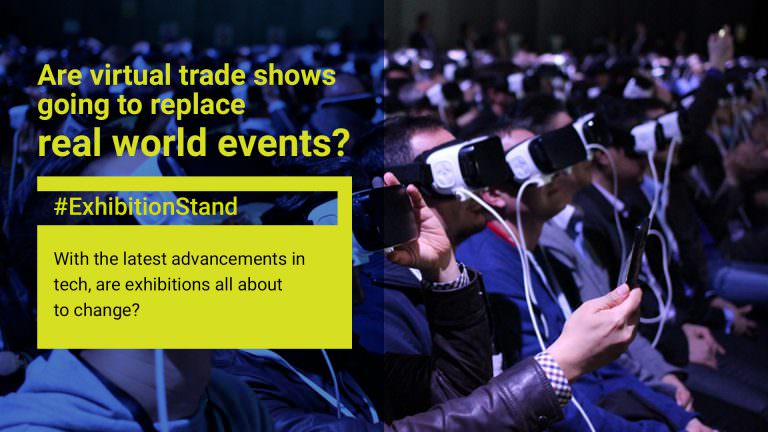 Add My Company
Add My Company

ARE VIRTUAL TRADE SHOWS GOING TO REPLACE REAL WORLD EVENTS?
For those of us who have earned our stripes in the world of exhibitions, the promise (or threat depending on your point of view!) of the virtual trade show isn’t anything new. But you could be forgiven for thinking the subject had gone away. It’s certainly true that, while a hot topic a few years ago, the concept didn’t take off; despite a few people investing in fancy websites where non-attendees to an actual event could ‘move around and through’ the various exhibition stands.
But, with the latest advancements in tech, is that all about to change?
Virtual reality (VR) is big news. And, with Apple having just quietly acquired a company that creates pioneering eye tracking software, it could become even bigger; with tech experts predicting that this investment could be key to making VR technology mainstream. Of course, accessible VR has implications for all industries. But for events and exhibitions, it could see us on the verge of the biggest evolution yet; removing the need for attendees to visit a physical location to interact with sellers. So, the possibility of the virtual trade show becoming the norm is far from dead.
Of course, most traditional exhibition companies will want to ignore this topic. Burying their heads in the sand and pretending that VR isn’t about to shake up life as they know it. But Apex isn’t your standard exhibition stand supplier, and we think it’s important to look at the world around us so we can discuss what these developments mean for our industry and our clients.
There is certainly an argument for the virtual tradeshow. And, in a time of squeezed budgets, it’s primarily financial. Just think about it; exhibitors could forget about paying for floor space, exhibition stands, and time away from the office and just pay for server space instead. And, for potential customers, all they’d need to attend an exhibition is to put on a headset. It’s compelling, right?
Or is it?
Certainly, in the near future, VR has the potential to provide exhibition visitors with amazing experiences that look a lot like real life ones. But let’s not pretend that for exhibitors, the cost of creating this experience will be cheap. Organisations will still need to invest in the creation of their stand and space, the only difference being that one actually exists as a physical structure. And, while proponents of VR might argue that once you have created a great digital experience it is cost effective to reuse it over and over again, that’s certainly nothing new for those of us who have been designing and building reconfigurable, modular exhibition stands for decades!
The next argument for the virtual tradeshow is that it widens your potential audience. That people from all over the world can attend without actually having to be there in person. And that’s true. But in reality, we all know how difficult it can be to make time to do anything outside of your usual duties when in the office. So, after the initial novelty wears off, exhibitors could find they’ve invested in a virtual tradeshow that fails to attract attendees for more than 30 minutes before getting interrupted. So there’s not much value for anyone involved.
Another case for the virtual tradeshow is that it can take place anywhere. Want to exhibit on the moon or under the ocean? No problem. There’s no denying the wow-factor such events would generate and, at Apex, capturing attention is one of our three simple steps to exhibition success. But, here again, once the originality wears off, businesses could find that the shows they are attending are all style and no substance – with a lack of relevancy actually detracting from their business objectives.
The tech needed to create virtual tradeshows is here, and it’s getting better and more affordable. But, while it might be the right approach for niche events, we believe that its integration into the mainstream is still a long while off. For most of us, the ability to interact with a potential supplier or customer, ‘kick the tyres’ of a product, attend seminars, and see what your competitors are up to in a place where you can actually take the time to engage on more than a superficial level is still best done face-to-face. And, getting out of the office/car for a day or two in a different city, where you can catch up over a bite to eat and enjoy a change from the usual 9-5 can have a massive impact on morale and productivity.
Of course, this doesn’t mean that there is no place for VR at exhibitions. Today’s show visitors are seeking experiences that are experimental and which evoke genuine emotions. As such, using interactive and immersive technology such as VR and AR (as well as games, video, etc.) gives people a reason to strike up conversations with you, experience the benefits of your product/services for themselves, and makes you uniquely memorable. But, when it comes to ditching real life tradeshows for entirely virtual exhibitions, the adage is true: just because you can do something, doesn’t mean you should.
For more information on Are virtual trade shows going to replace real world events? talk to Apex.co.uk

